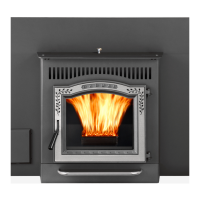6
Save These Instructions3-90-775R36_09/15
A. Design, Installation & Location Considerations
1. Appliance Location
Considerationmustbegiventosafety,convenience,trafc
ow,andthefactthattheappliancewillneedtobevented
to the outside. This appliance may only be installed into
an existing masonry or manufactured wood-burning
replace or using the optional zero-clearance cabinet
to build into a newly constructed chase. It is a good idea
toplanyourinstallationonpaper.Useexactmeasurements
forclearancesandoorprotection,beforeactuallybeginning
the installation.
Maintain specied vent clearance to combustible
requirements listed by the vent manufacturers instructions
and all appliance clearances as listed in this manual.
Check with your local building code agency before you
begin your installation. Local codes may supersede the
testlaboratoriesspecications.Alwaysobtainanyrequired
permit(s) so that insurance protection benets cannot be
unexpectedlycancelled.Ifanyassistanceisrequiredduring
installation, please contact your dealer.
Werecommendthataqualiedbuildinginspectorandyour
insurance company representative review your plans before
and after the installation.
2. Room Sensor Location
The room sensor's location will have some effect on the
appliance'soperation.Whenthesensorislocatedcloseto
the appliance, it mayrequire a higher setting tokeep the
rest of the house comfortable. If the sensor is located in
an adjacent room, or farther away from the stove, you will
notice higher temperatures near the appliance.
B.FireSafety
Maintain the designated clearances to combustibles.
Insulation must not touch the chimney. You must maintain the
designated air space around the chimney. This space around
a chimney is necessary to allow natural heat removal from
the area. Insulation in this space will cause a heat buildup,
which may ignite wood framing. NOTE: Clearances may
only be reduced by means approved by the regulatory
authority having jurisdiction.
To provide reasonable re safety, the followingshould be
given serious consideration:
1. Install at least one smoke detector on each oor of
your home. Detectors should be located away from
the heating appliance and close to sleeping areas.
Follow the smoke detector manufacturer's placement
and installation instructions, and be sure to maintain
regularly.
2. A conveniently located Class A re extinguisher to
contendwithsmallresresultingfromburningembers.
3. A practiced evacuation plan, consisting of at least two
escape routes.
4. Aplantodealwithahopperreasfollows:
Intheeventofahopperre:
a.Turnapplianceto"OFF".
b. Be sure hopper lid is closed and latched.
c. Notify Fire Department.
d.DoNOTpourwaterinthehopper.
e. Never pull the plug or otherwise disconnect the
powersupplytokillare.
• Do NOT connect this unit to a chimney flue
servicing another appliance.
• DoNOTconnecttoanyforcedairdistributionduct
or system.
CAUTION
Fire Hazard
• Do not operate appliance before
reading and understanding the
operating instructions.
• Failure to operate properly may
causeahousere.
WARNING
4
Getting Started
Installation and service of this
appliance should be performed by
qualiedpersonnel.Hearth&Home
Technologies recommends HHT
Factory Trained or NFI Certied
professionals.

